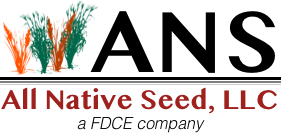
Native wildflowers, shrubs, and grasses that provide food and shelter for a variety of songbirds.
Creating a bird-friendly landscape isn’t just rewarding for birdwatchers, it’s also a meaningful way to restore local ecosystems and contribute to wildlife conservation. For landowners participating in the Conservation Reserve Program (CRP) or simply looking to enhance biodiversity, incorporating native plants is one of the most effective strategies to attract and support songbirds year-round.
At All Native Seed (ANS), we specialize in native seed mixes that benefit not only the soil and pollinators but also the songbirds that rely on these habitats for food, nesting, and shelter. Here’s a guide to the top native plants that can transform your land into a haven for songbirds.
Native Grasses: Nesting and Shelter
Native warm-season grasses provide crucial cover and nesting habitat for ground-nesting and low-perching birds. Their open-ground structure and upright growth pattern allow birds to navigate safely while staying protected from predators.
Little Bluestem (Schizachyrium scoparium)
- Clump-forming grass that offers excellent nesting cover.
- Attracts insects that serve as food for birds.
Switchgrass (Panicum virgatum)
- Tall, dense growth provides shelter and winter roosting cover.
- Seeds are eaten by finches, sparrows, and buntings.
Indiangrass (Sorghastrum nutans)
- Offers structure for nesting and shelter.
- Supports a wide range of insects that birds feed on.
Native Wildflowers: Food from Seeds and Insects
Wildflowers provide two key resources: nectar and pollen for insects (which birds eat) and seeds for direct bird consumption. Planting a diversity of forbs that bloom across seasons ensures continuous food sources.
Black-Eyed Susan (Rudbeckia hirta)
- Seeds attract goldfinches and chickadees.
- Blooms support pollinators and beneficial insects.
Purple Coneflower (Echinacea purpurea)
- Produces seed heads that birds feed on through fall and winter.
- Pollinator-friendly plant that increases insect populations.
Maximilian Sunflower (Helianthus maximiliani)
- Offers large seedheads that attract finches, grosbeaks, and sparrows.
- Tall stems provide late-season structure and cover.
Partridge Pea (Chamaecrista fasciculata)
- Fixes nitrogen and attracts insects and butterflies.
- Seeds are eaten by bobwhites and songbirds.
Native Shrubs: Shelter, Nesting Sites, and Berries
If your CRP plan or property allows for shrub plantings, including native woody species can provide essential winter food sources and protected nesting areas.
American Plum (Prunus americana)
- Offers spring flowers for insects and fall fruit for birds.
- Provides dense cover for nesting and roosting.
Elderberry (Sambucus canadensis)
- Produces clusters of berries enjoyed by thrushes, catbirds, and waxwings.
- Shrub thickets support hiding spots and nesting.
Serviceberry (Amelanchier spp.)
- Early-blooming shrub with edible berries.
- Supports a wide variety of bird species and pollinators.
Tips for Planting and Management
- Mix for diversity: A successful bird habitat includes a variety of grasses, forbs, and, when appropriate, shrubs for vertical structure and seasonal resources.
- Use local ecotype seed: Native species adapted to your region will perform best and offer the most ecological value.
- Avoid pesticides: Insect populations are critical for many songbirds, especially during nesting season.
- Leave seed heads: Delay mowing or clearing until spring to allow birds access to seeds during the winter months.
Bring Songbirds Back to Your Land
By choosing the right native plants, you’ll provide food, nesting opportunities, and safe shelter for a wide array of songbirds. Whether you’re managing land under a CRP contract or pursuing private habitat restoration, All Native Seed can help you select the most effective, USDA-compliant seed mix for your goals.
Ready to start planning your songbird habitat?
Reach out to the team at All Native Seed for guidance on seed selection, planting strategies, and long-term habitat success.
